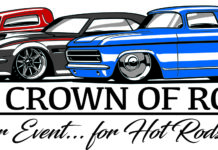“Clevor” The Perfect Cleveland & Windsor Engine Build
By Ron Ceridono
For many automobile racing fans some of the most unique series of events were the Sports Car Club of America (SCCA) Trans-Am races that began in 1966. Despite the name of the sponsoring body the real stars of the show weren’t imported sports cars, rather it was the made in the USA “pony” cars in the production that got everyone’s attention. The sight and sound of these cars battling door to door sparked intense brand loyalty, something that was not lost on the manufacturers. And there’s no question that the “win on Sunday, sell on Monday” strategy served them well.

To compete in the Trans-Am production class manufacturers had to go through the homologation process, which meant a certain number of “race” cars had to be available to the general public on showroom floors. The result of this process gave us some legendary cars, such as the Camaro Z28, Pontiac Firebird Trans-Am, American Motors Javelin SST Trans Am Edition, Plymouth AAR Cuda, T/A Challenger, and others, including the Boss 302 Mustang.

To be competitive in the Trans-Am production class Ford developed the Boss 302 V8 engine. Available in 1969 and 1970 Mustangs, these small block engines were based on high nickel block castings with four-bolt mains and screw-in soft plugs. But what really made the engine different from the standard 302 Windsor small block engines were the canted valve heads that were destined to be on the 351 Cleveland series of engines. These heads were vastly superior to the Windsor heads of the day; as the bore spacing and head bolt patterns were the same on the Windsor and Cleveland block, heads would interchange.

Read More: Mom’s 1967 Pontiac GTO
The canted valve Cleveland heads offered a number of advantages compared to the standard Windsor inline valve arrangement. The Cleveland heads have big valves with generous ports that have straight paths in and out of the cylinders. It should be noted that production Cleveland heads came in two configurations, 2V (2 venturi) and 4V (four venturi). The 351C-2V heads have smaller ports than the 4V that provide increased air velocity at lower engine speeds with open combustion chambers that result in a lower compression ratio for use with today’s pump gas. By comparison the 4V heads have huge ports that breathe extremely well at high rpm and closed, high-compression wedge chambers.

As part of the Kugel Komponents family, Joe Kugel has taken part in the construction of a long list of outstanding hot rods for customers, and more than just a few were ’32 Ford roadsters. But in the back of Kugel’s mind was a vision of the car he wanted to build; the result of that vision is what he calls the “32MyWay” (see the Modern Rodding May ’23 issue for a full feature). While Kugel knew what he wanted his roadster to look like, as a member of Bonneville’s prestigious 200- and 300-mph clubs, performance figured into his plans as well. To that end he decided on an equally unique engine, a 427ci small block Boss V8 and an engine Ford never built.

Handling the engine build was Mike LeFever of Redline Performance. The foundation of the bigger Boss is a Dart cast-iron block (PN 31385295) with a 4.125 bore and 9.200-inch deck height. It comes with four-bolt billet steel main caps; the three center caps have splayed outer bolts for maximum strength. The lubrication system has been upgraded with a low restriction priority main oiling system with external oil pump feed and the reinforced head bolt bosses are blind tapped to prevent leaks and produce accurate torque readings (extra-thick decks prevent head gasket leaks). Inside the Dart block is a Scat forged crank (PN 4-351C-4000-6200-2) with a 4-inch stroke. It connects to custom forged pistons with Scat H-beam rods (PN 6625021SA-1).

Read More: Timeless 1955 Ford Fairlane Victoria
To make this bigger Boss aluminum Edelbrock Performer RPM cylinder heads, PN 61625 was used. With the 2V port configurations the intake runner volume is 190 cc; combined with 2.05-inch intake valves and 1.60 exhaust valves these heads deliver great throttle response and power from 1,500 to 6,500 rpm. Combustion chamber volume is 60 cc and the heads came with pushrod guideplates.

To adapt the Edelbrock Cleveland heads to the Winsor block Kugel turned to Price Motorsports Engineering (PME). Mary and Bill Price make a variety of adapters to install Cleveland-style heads on Windsor and other Ford blocks. In this case, due to the deck height of the block, their AP 16 kit (Cleveland 2V heads to a 351 Windsor block) was used to fill the gap between the Cleveland heads and the Windsor intake manifold. These adapters also provide passages to route the coolant so it exits the intake manifold.

Although the Windsor rectangular ports and the Cleveland 2V head ports are the same height and width, they have slightly different corner contours. The adapters are made to match the intake and as Price explains, “This leaves very little of the Cleveland port showing when the plate is laid on for installation. This material can easily be removed or left alone.”

Read More: How To Retain Your Classic Car’s Original Frame
Topping off the 427 is an eight-stack Borla throttle body electronic fuel injection system. We all know looks can be deceiving and this case what looks to be classic quartet of Weber carburetors are actually state-of-the-art, computer-controlled throttle bodies. The aluminum intake manifold has cast-in plenum facilities for the MAP sensor and idle air control while the throttle position sensor mounts to one of the throttle bodies. The fuel rail includes an adjustable fuel pressure regulator that’s good up to 1,400 BHP.

The Boss 302 Mustangs had a short but colorful two-year Trans-Am career. Various issues plagued Bud Moore’s Ford team, arguably costing them the ‘69 Trans-Am season championship. The following year Moore won the Trans-Am champion with Parnelli Jones driving. Then in ‘71, Ford and all the other manufacturers dropped factory support for Trans-Am, as a result the glorious Boss 302 ended, but that doesn’t mean you can’t have one. While an original Boss 302 is nearly impossible to find, there are options available, like Kugel Komponents’s CLEVOR 427, the engine Ford didn’t build. MR








Sources
ARP
(800) 826-3045
arp-bolts.com
Borla Performance Industries
(877) 772-6752
borlainduction.com
Dart Machinery
(248) 362-1188
Dartheads.com
Edelbrock
(310) 781-2222
Edelbrock.com
Kugel Komponents
(562) 691-7006
Kugelkomponents.com
Mike LeFever/Redline Performance
(714) 777-5758
Redlineperformance.com
MSD
(866) 464-6553
Holley.com
Price Motorsports Engineering
(812) 546-4220
Pricemotorsport.com
Click on this issue’s cover to see the enhanced digital version of The Boss 427 Ford Never Made.





























